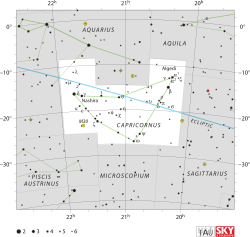Zeta Capricorni
Zeta Capricorni, Latinized from ζ Capricorni, is a fourth-magnitude star in the constellation Capricornus. ζ Capricorni is a binary star, with the primary component ζ Capricorni A being a yellow G-type giant with an apparent magnitude of +3.77. It is considered one of the prototypical examples of a Barium star, properties of which include overabundances of carbon molecules (such as C2) and s-process elements. Zeta Capricorni has an overabundance of the s-process element praseodymium.
 | |
| Observation data Epoch J2000 Equinox J2000 | |
|---|---|
| Constellation | Capricornus |
| Right ascension | 21h 26m 40.02634s[1] |
| Declination | −22° 24′ 40.8042″[1] |
| Apparent magnitude (V) | 3.74[2] |
| Characteristics | |
| Spectral type | G8IIIp / DA2.2[3] |
| U−B color index | +0.57[4] |
| B−V color index | +0.99[4] |
| Astrometry | |
| Radial velocity (Rv) | 2.10[2] km/s |
| Proper motion (μ) | RA: -2.23[1] mas/yr Dec.: 18.10[1] mas/yr |
| Parallax (π) | 8.46 ± 0.21[1] mas |
| Distance | 386 ± 10 ly (118 ± 3 pc) |
| Absolute magnitude (MV) | −1.59[5] |
| Orbit[6] | |
| Primary | ζ Cap A |
| Companion | ζ Cap B |
| Period (P) | 2378.2 d |
| Semi-major axis (a) | 8.56 ± 4.3 mas |
| Eccentricity (e) | 0.2821 |
| Inclination (i) | 111.7 ± 20.7° |
| Longitude of the node (Ω) | 190.7 ± 50.0° |
| Periastron epoch (T) | JD 2445996 |
| Argument of periastron (ω) (secondary) | 233.8 ± 19.8° |
| Details | |
| ζ Cap A | |
| Mass | 3.99 ± 0.12[7] M☉ |
| Radius | ~29[8] R☉ |
| Luminosity | 490[7] L☉ |
| Surface gravity (log g) | 1.48 ± 0.16[9] cgs |
| Temperature | 5397 ± 82[9] K |
| Metallicity [Fe/H] | −0.14 ± 0.10[9] dex |
| ζ Cap B | |
| Mass | 1[3] M☉ |
| Temperature | 23000[3] K |
| Other designations | |
| Database references | |
| SIMBAD | data |
Its companion, ζ Capricorni B is a hydrogen-rich white dwarf. It is about as massive as the Sun, and its temperature is 23,000 K.[3]
The ζ Capricorni binary system is approximately 390 light years from Earth, based on its parallax.[1]
Chinese Name
In Chinese, 十二國 (Shíer Guó), meaning Twelve States, refers to an asterism which represents twelve ancient states in the Spring and Autumn period and the Warring States period, consisting of ζ Capricorni, φ Capricorni, ι Capricorni, 38 Capricorni, 35 Capricorni, 36 Capricorni, χ Capricorni, θ Capricorni, 30 Capricorni, 33 Capricorni, 19 Capricorni, 26 Capricorni, 27 Capricorni, 20 Capricorni, η Capricorni and 21 Capricorni.[10] Consequently, the Chinese name for ζ Capricorni itself represents the state of Yan (燕).,[11] together with ν Ophiuchi in Left Wall of Heavenly Market Enclosure (asterism).[12]
References
- "HD 204075 -- Star in double system". SIMBAD Astronomical Database. Retrieved 2007-04-01.
- Jim Kaler: Zeta Capricorni
- van Leeuwen, F. (2007). "Validation of the new Hipparcos reduction". Astronomy and Astrophysics. 474 (2): 653–664. arXiv:0708.1752. Bibcode:2007A&A...474..653V. doi:10.1051/0004-6361:20078357. Vizier catalog entry
- "zet Cap". SIMBAD. Centre de données astronomiques de Strasbourg. Retrieved 28 December 2016.
- Holberg, J. B.; Oswalt, T. D.; Sion, E. M.; Barstow, M. A.; Burleigh, M. R. (2013). "Where are all the Sirius-like binary systems?". Monthly Notices of the Royal Astronomical Society. 435 (3): 2077. arXiv:1307.8047. Bibcode:2013MNRAS.435.2077H. doi:10.1093/mnras/stt1433.
- Mermilliod, J.-C. (1986). "Compilation of Eggen's UBV data, transformed to UBV (unpublished)". Catalogue of Eggen's UBV Data. Bibcode:1986EgUBV........0M.
- Anderson, E.; Francis, Ch. (2012), "XHIP: An extended hipparcos compilation", Astronomy Letters, 38 (5): 331, arXiv:1108.4971, Bibcode:2012AstL...38..331A, doi:10.1134/S1063773712050015.
- Pourbaix, D. (2000). "Re-processing the Hipparcos Transit Data and Intermediate Astrometric Data of spectroscopic binaries. I. Ba, CH and Tc-poor S stars". Astronomy and Astrophysics Supplement. 145: 161–183. arXiv:astro-ph/0006175. Bibcode:2000A&AS..145..161P. doi:10.1051/aas:2000346.
- Hohle, M.M.; Neuhäuser, R.; Schutz, B.F. (2010). "Masses and luminosities of O- and B-type stars and red supergiants". Astronomische Nachrichten. 331 (4): 349. arXiv:1003.2335. Bibcode:2010AN....331..349H. doi:10.1002/asna.200911355.
- "ZETA CAP (Zeta Capricorni)". Retrieved 30 December 2016.
- Prugniel, Ph.; et al. (July 2011). "The atmospheric parameters and spectral interpolator for the MILES stars". Astronomy & Astrophysics. 531: A165. arXiv:1104.4952. Bibcode:2011A&A...531A.165P. doi:10.1051/0004-6361/201116769.
- (in Chinese) 中國星座神話, written by 陳久金. Published by 台灣書房出版有限公司, 2005, ISBN 978-986-7332-25-7.
- Richard Hinckley Allen: Star Names — Their Lore and Meaning: Capricornus
- (in Chinese) AEEA (Activities of Exhibition and Education in Astronomy) 天文教育資訊網 2006 年 6 月 23 日